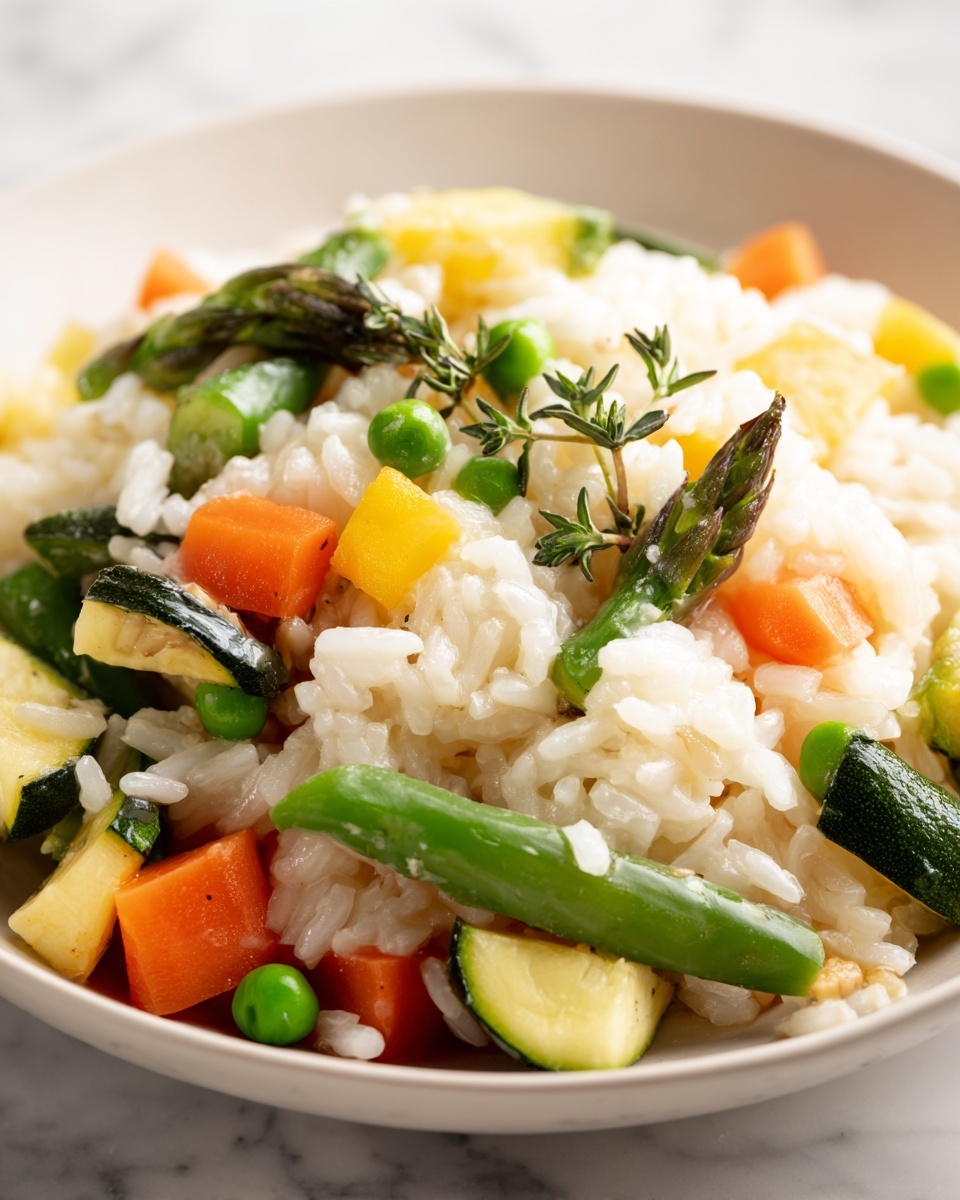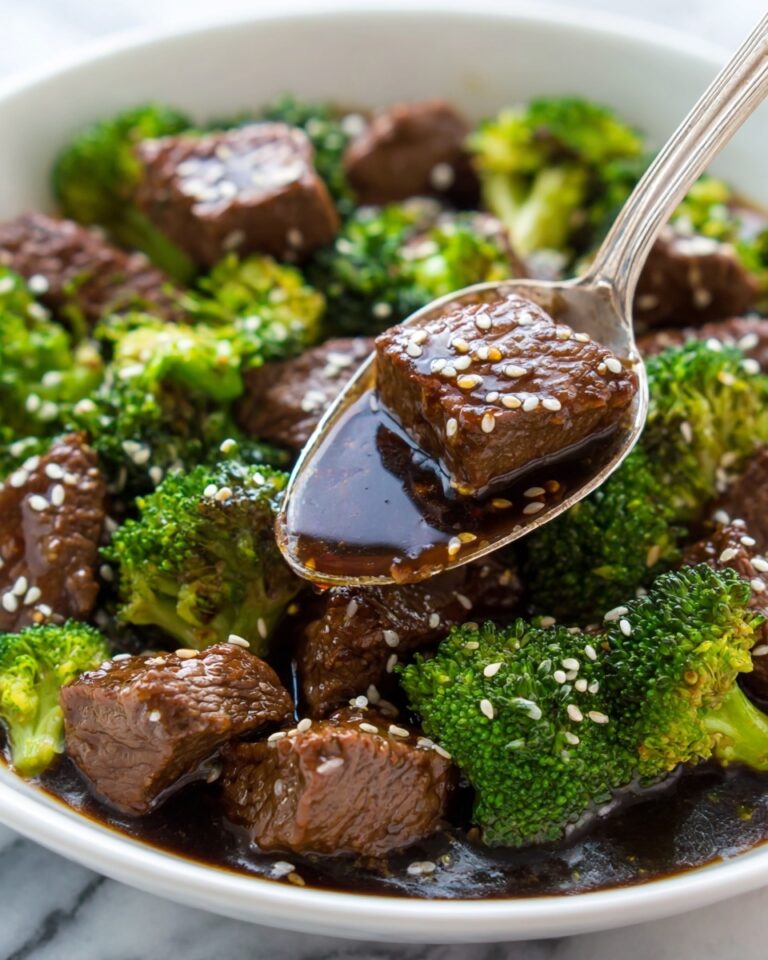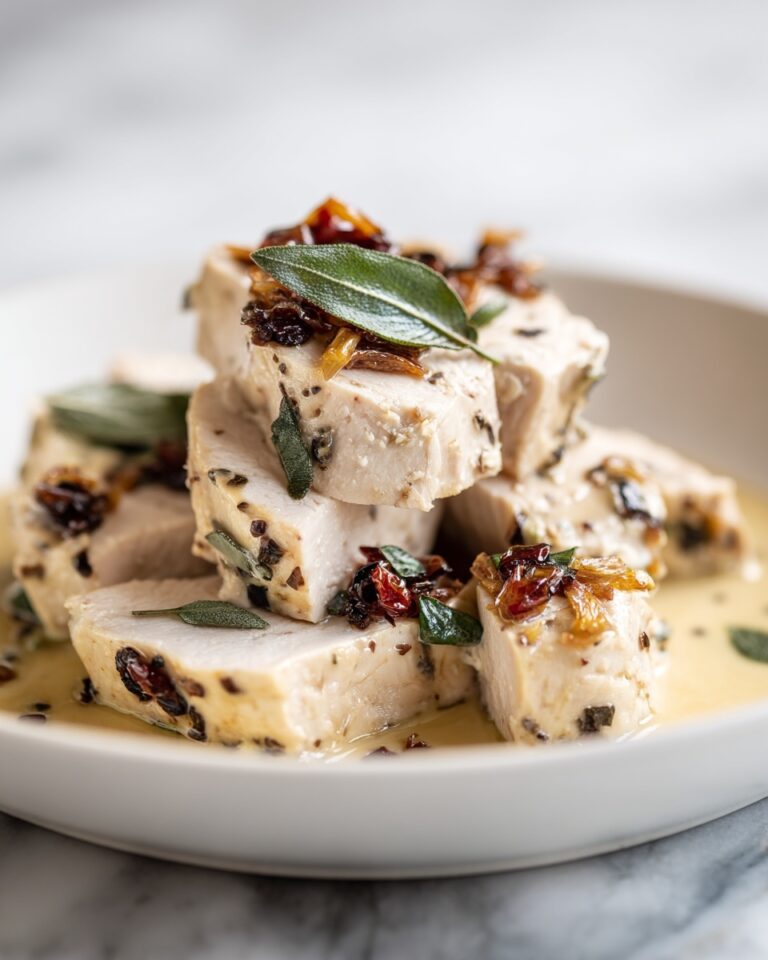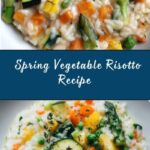If you are looking to celebrate the fresh flavors of the season, this Spring Vegetable Risotto Recipe is an absolute delight. Creamy, comforting, and bursting with vibrant green vegetables, it perfectly balances indulgence with freshness. Each bite is a beautiful harmony of tender Arborio rice soaked in fragrant broth, tender asparagus and peas, and a hint of lemon brightness to elevate every mouthful. Whether you’re cooking for family or friends, this dish offers a lovely way to enjoy spring’s bounty in a cozy, elegant meal that feels both special and homey.
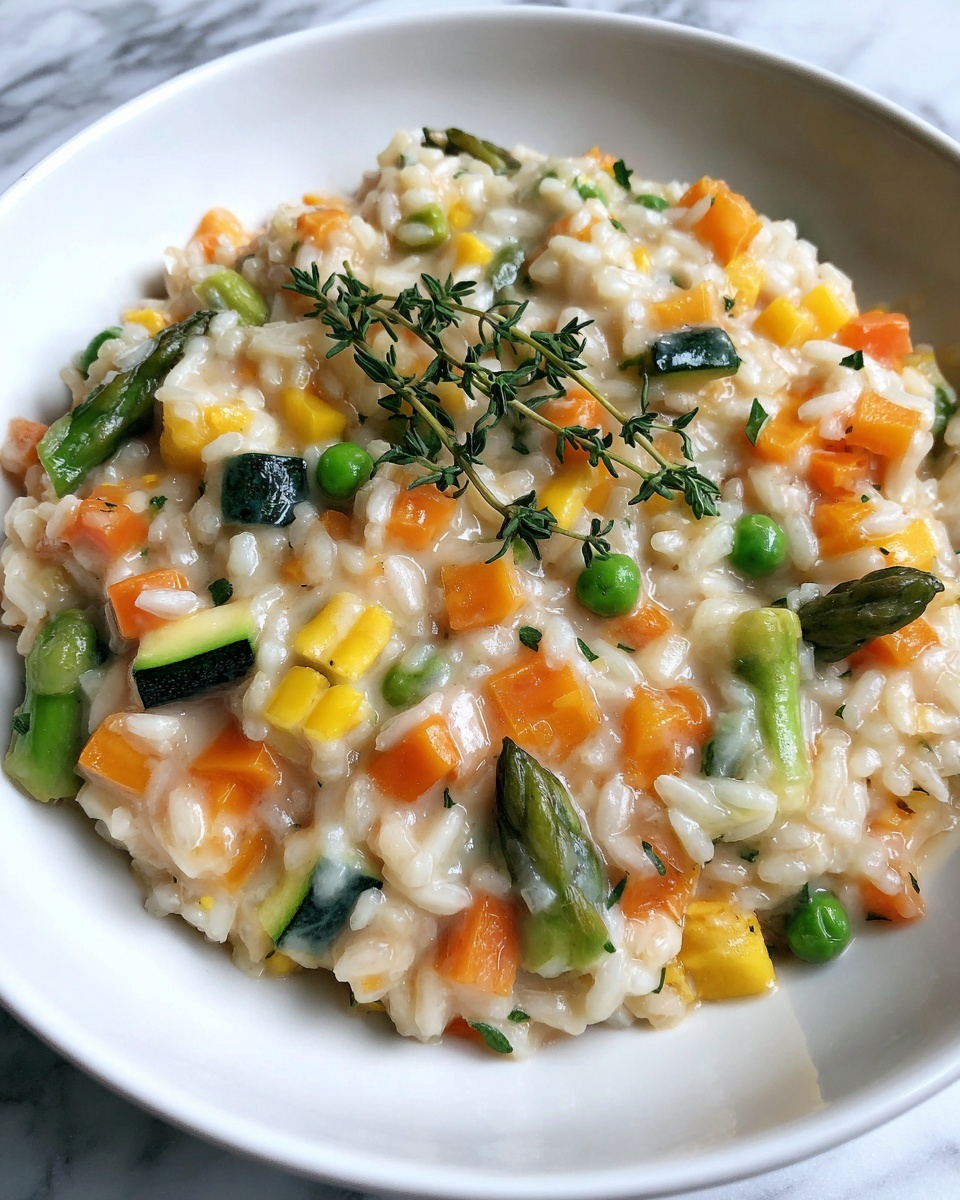
Ingredients You’ll Need
The magic of this Spring Vegetable Risotto Recipe lies in its simple, yet carefully chosen ingredients. Each one adds a distinct layer of taste, texture, or color, creating a vibrant dish with minimal fuss.
- Olive oil: Adds a fruity richness and helps sauté the vegetables gently.
- Unsalted butter: Brings a silky texture and enhances the creamy finish of the risotto.
- Small leek: Offers a mild onion flavor that softly infuses the base.
- Asparagus: Contributes fresh, slightly sweet green notes and a satisfying bite.
- Frozen peas: Instant hits of sweetness and vibrant color that brighten the dish.
- Arborio rice: The essential risotto rice that creates the signature creamy, tender texture.
- Dry white wine: Adds depth and a subtle acidity to balance the richness.
- Vegetable broth: Infuses flavor as it gently cooks the rice to perfection.
- Grated Parmesan cheese: Delivers salty, nutty notes and richness.
- Salt and pepper: Season to taste for well-rounded flavor.
- Fresh lemon juice: Brightens and lifts the whole dish with a zesty finish.
- Fresh parsley: For a fresh herbaceous garnish that adds color and freshness.
How to Make Spring Vegetable Risotto Recipe
Step 1: Sauté the Leek and Vegetables
Start by heating the olive oil and butter together in a large pan over medium heat. Add the thinly sliced leek first and cook it gently, stirring now and then, until it softens and becomes fragrant, about 3 to 4 minutes. Then toss in the chopped asparagus and frozen peas, cooking them for another 2 to 3 minutes until they start to soften but still hold some crunch. This gentle cooking preserves their fresh, springtime texture and flavor, setting the stage for the risotto’s creamy base.
Step 2: Toast the Arborio Rice
Now, stir in the Arborio rice to the pan, allowing it to toast lightly for 1 to 2 minutes. This step is crucial because it helps the grains maintain their perfect al dente bite by coating them in the oil and gently warming them before adding any liquid.
Step 3: Add White Wine
Pour in the dry white wine and stir continuously. The rice will absorb the wine slowly, soaking up that subtle acidity and depth while the alcohol cooks off. This adds a nuanced flavor dimension that complements both the cheese and the bright vegetables.
Step 4: Gradually Add Warm Broth
This step requires patience, but it’s where the magic happens. Add the warm vegetable broth one ladle at a time, stirring constantly and waiting until the rice has absorbed most of the liquid before adding more. This slow, steady release of broth encourages the rice to release its natural starches, creating that signature luscious, creamy texture that defines a great risotto. Keep this process going for 18 to 20 minutes, until the rice is tender but still offers a slight bite.
Step 5: Final Flavor Touches
Once the rice is perfectly cooked, fold in the grated Parmesan cheese and fresh lemon juice. Season with salt and pepper to your preference. Let everything cook together for another 2 to 3 minutes so the flavors meld beautifully and the cheese melts into the creamy risotto. This final step gives the dish a rich, tangy pop that keeps it vibrant and satisfying.
Step 6: Serve Warm and Garnished
Serve the risotto while it’s warm, topped generously with freshly chopped parsley and a little extra Parmesan if you like. This adds a lovely herbal fragrance and a beautiful visual contrast that makes the dish feel as good as it tastes.
How to Serve Spring Vegetable Risotto Recipe
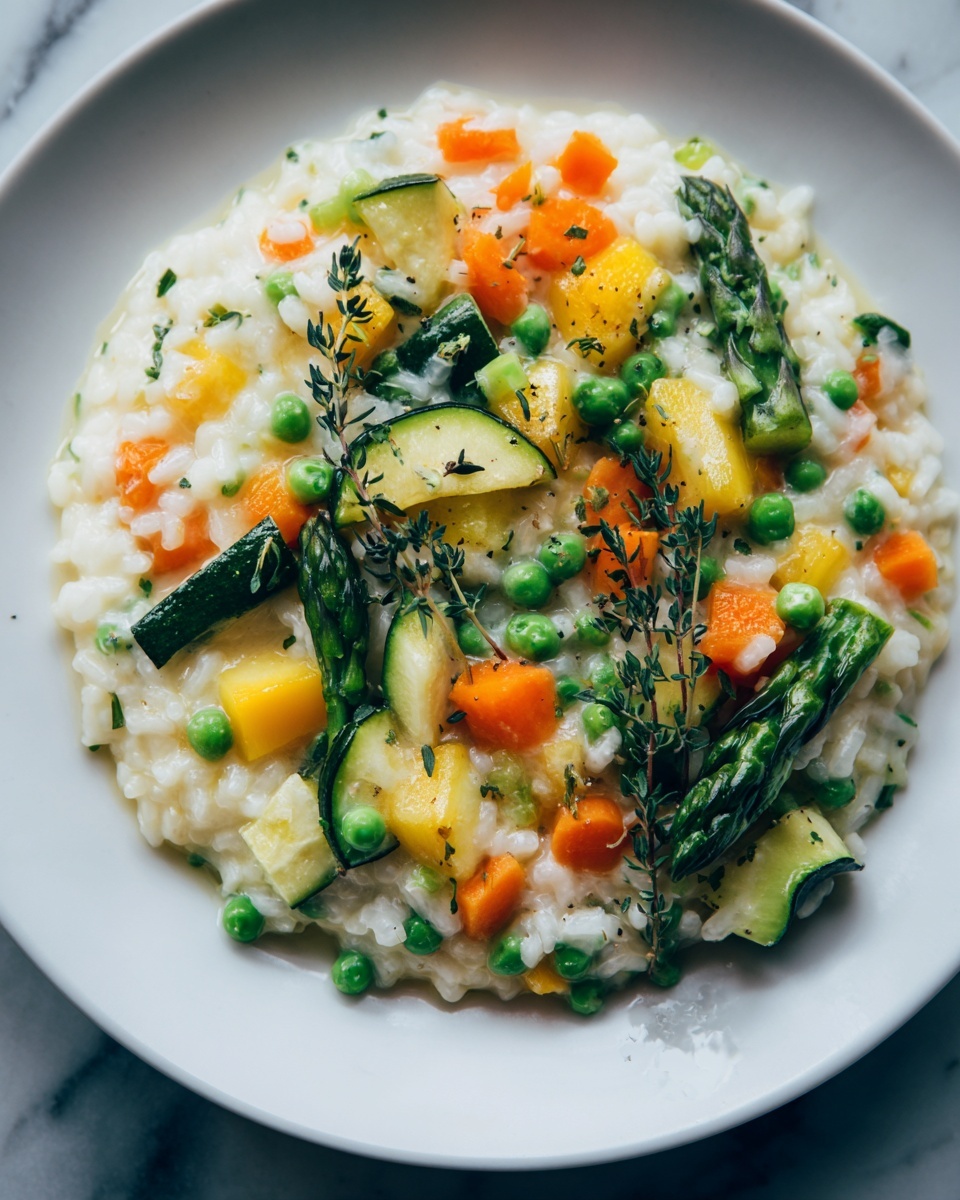
Garnishes
Fresh parsley is a classic choice for garnishing this risotto—it adds bursts of herbal brightness and a lovely pop of color. You could also try a sprinkle of lemon zest or a few shavings of Parmesan cheese for extra indulgence and visual appeal. A drizzle of good-quality olive oil just before serving helps add a silky finish and a touch of richness.
Side Dishes
Because this risotto is so creamy and filling, light sides work best. A crisp green salad with lemon vinaigrette or roasted cherry tomatoes complements the dish’s richness beautifully. You could also serve it alongside grilled chicken or a simple baked fish to make it a complete meal with a balance of protein and vegetables.
Creative Ways to Present
For an elegant dinner party, consider serving the risotto in individual shallow bowls or wide-rimmed plates that showcase its color and texture. Garnish each portion with a small sprig of fresh parsley and a lemon wedge on the side for guests to squeeze if they like. You can also spoon the risotto into hollowed-out spring vegetables, like zucchini boats, for a playful and seasonal presentation.
Make Ahead and Storage
Storing Leftovers
Leftover Spring Vegetable Risotto Recipe keeps well in an airtight container in the refrigerator for up to 3 days. The texture may thicken as the rice absorbs more liquid, but careful reheating can restore its creaminess.
Freezing
Freezing risotto is not ideal because the rice tends to become grainy and lose its creamy texture. If you must freeze it, cool it quickly, store it in a freezer-safe container, and consume within 1 month. Thaw gently in the refrigerator overnight before reheating.
Reheating
To reheat, add a splash of vegetable broth or water to the risotto and warm it gently on the stove over low heat, stirring frequently. This will help to loosen the rice and bring back the luscious creaminess. Avoid using the microwave if possible, as it can dry out the dish unevenly.
FAQs
Can I use different vegetables in this risotto?
Absolutely! The beauty of this Spring Vegetable Risotto Recipe is its flexibility. Feel free to swap in other spring veggies like snap peas, baby spinach, or zucchini according to what you have on hand or prefer.
Do I have to use white wine? What if I don’t drink alcohol?
You can leave out the white wine if you prefer. Simply replace it with an equal amount of broth or a splash of lemon juice to keep the acidity that brightens the risotto.
Is Arborio rice necessary?
Arborio rice is the best choice for risotto due to its high starch content, which creates that creamy texture. If you can’t find it, other medium-grain rice varieties might work, but the texture won’t be quite the same.
Can this recipe be made vegan?
Yes! Just swap the butter for a plant-based option and omit the Parmesan or use a vegan cheese substitute to keep the dish creamy and delicious.
How can I tell when the risotto is perfectly cooked?
The risotto should be tender with a slight firm bite in the center—known as al dente—and have a creamy, luscious consistency. The grains should not be mushy or dry.
Final Thoughts
This Spring Vegetable Risotto Recipe is a true celebration of seasonal freshness combined with comforting creaminess that’s perfect for any occasion. It’s simple enough for a weeknight, yet elegant enough to impress guests. Once you try it, the harmony of flavors and textures will make it a go-to recipe in your kitchen during the warmer months. So grab those fresh vegetables, and get ready to enjoy a dish that’s as joyful to make as it is to eat!
Print
Spring Vegetable Risotto Recipe
- Prep Time: 10 minutes
- Cook Time: 30 minutes
- Total Time: 40 minutes
- Yield: 4 servings
- Category: Main Course
- Method: Stovetop
- Cuisine: Italian
- Diet: Vegetarian
Description
This Spring Vegetable Risotto is a creamy, comforting dish bursting with fresh, vibrant flavors from tender leeks, asparagus, and peas. Cooked slowly with Arborio rice and white wine, and finished with Parmesan cheese and lemon juice, it offers a perfect balance of richness and brightness, ideal for a delightful springtime meal.
Ingredients
Vegetables and Herbs
- 1 small leek, cleaned and thinly sliced
- 1/2 cup asparagus, chopped
- 1/2 cup frozen peas
- Fresh parsley, chopped (for garnish)
Liquids and Fats
- 1 tbsp olive oil
- 1 tbsp unsalted butter
- 1/2 cup dry white wine
- 4 cups vegetable broth, kept warm
- 1 tbsp fresh lemon juice
Grains and Cheese
- 1 cup Arborio rice
- 1/2 cup grated Parmesan cheese
Seasonings
- Salt and pepper, to taste
Instructions
- Sauté the Leek: Heat olive oil and butter in a large pan over medium heat. Add the thinly sliced leek and cook, stirring occasionally, until softened, about 3-4 minutes.
- Add Spring Vegetables: Add the chopped asparagus and frozen peas to the pan, cooking for another 2-3 minutes until they become slightly tender.
- Toast the Rice: Stir in the Arborio rice and cook for 1-2 minutes, allowing the rice to lightly toast and absorb flavors.
- Deglaze with Wine: Pour in the dry white wine and stir continuously until the liquid is fully absorbed by the rice.
- Cook the Risotto: Gradually add the warm vegetable broth one ladle at a time, stirring constantly. Allow the rice to absorb the liquid before adding more. Continue this process for 18-20 minutes until the rice is tender, creamy, yet slightly al dente.
- Finish with Cheese and Seasoning: Once the rice is cooked, stir in the grated Parmesan cheese, fresh lemon juice, salt, and pepper to taste. Cook for an additional 2-3 minutes to heat through and blend all flavors.
- Serve: Spoon the risotto into serving dishes and garnish with chopped fresh parsley and, if desired, an extra sprinkle of Parmesan cheese. Serve warm for best taste.
Notes
- Keep the vegetable broth warm throughout cooking to ensure the risotto cooks evenly.
- Stirring constantly helps release the rice’s starches for a creamy texture.
- Use dry white wine that you enjoy drinking for the best flavor.
- For a vegan version, omit Parmesan cheese or substitute with a plant-based cheese alternative.
- Adjust seasoning at the end to prevent over-salting.

